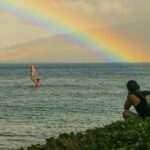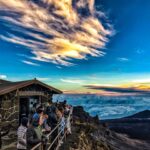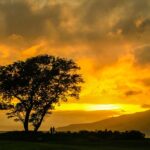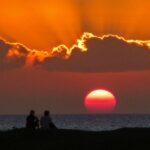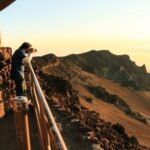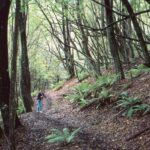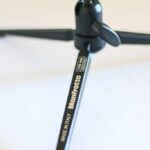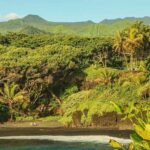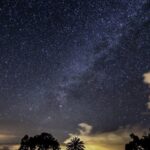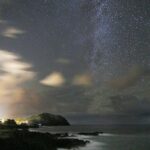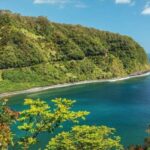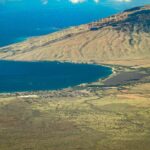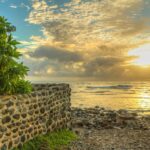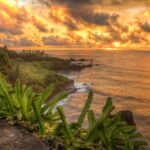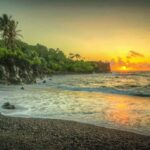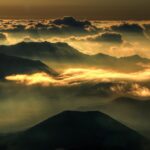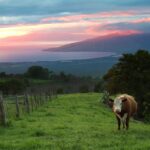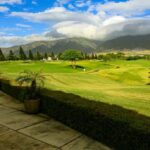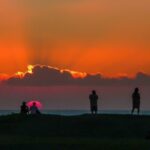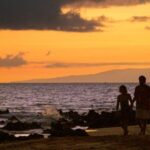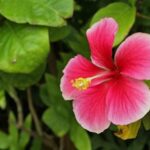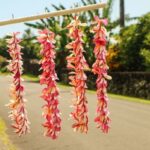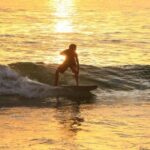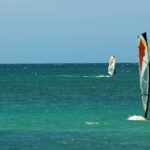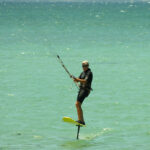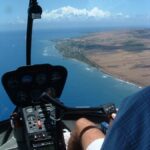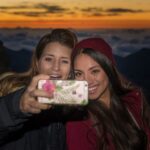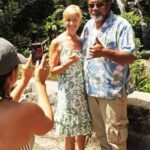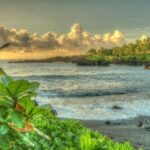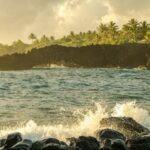Photography Tips
How To Capture Great Maui Vacation Photos
As a professional photographer working in Maui for over 20 years I can tell you that every day there is something beautiful to photograph here. Being a teaching artist for the last 12 years I’ve created some of my most memorable images of Maui while teaching. I’ve done photo workshops throughout the island and at Hui No’eau Visual Arts Center a few miles from the beautiful upcountry town of Makawao. This amazing property has endless photo opportunities and I highly recommend stopping by or look into taking a class there while you’re visiting Maui.
I always tell my photo students that there is a difference between taking a photo and making a photo. Get the overall “in the can” image and then give yourself permission to get creative. My favorite definition of getting creative is to get closer – then closer – then CLOSER. Clean up your background and simplify. Less is more even in a grand landscape image.
I feel that photography can motivate us to savor life more intensely. Getting up for sunrise or hanging around on the beach after sunset can be the highlight of an entire vacation, not just for the images but for the experience. It’s not hard to get some decent travel photos in Maui but there are some challenges to creating memorable images in this harsh tropical sunlight. Let me share a few of my favorite tips with you that can help improve the capturing of your best moments in Maui.
There are many types of cameras and phones in use today and most of this info will apply to all but some of it will be about DSLR and digicam techniques plus some tips about video filming. I’ll also include some tricks for phone users including some of my favorite apps.
But first the overall stuff…
Photography Techniques
Composition – The Rule of Thirds
The rule of thirds is used by all visual artists and at it’s core this rule says, “Don’t put anything in the center”! It doesn’t mean this rule can’t be broken with great success but I notice that a lot of people don’t fill the frame enough and end up with too much distracting background clutter around a centered subject. We don’t read from the center of a page out and a creative image should have some element of flow. I suggest framing subjects in the four quadrants of intersecting lines of the rule of thirds and especially try to keep horizon lines (especially the ocean) in the upper or lower third of the frame. It’s not meant to be an exact science but it is a great starting point. Placing people in these quadrants of a grand scenic is also great because it gives the landscape scale. Sometimes I will put the camera on self timer and jump in the shot myself with my back to the camera. Publishers love this as people viewing images in print can place themselves in the image as long as there are no recognizable faces.
Framing
Horizontal framing is for landscapes and vertical framing is for portraits. I would say it’s better to think of framing as matching the shape of your subject. For instance a single flower is taller than it is wide so frame it vertically. I usually frame both horizontal and vertical so publishers have a selection to choose from depending on the various layouts they may use. Also, diagonal framing says “Fun” so try it – just remember to fill the frame…get closer…and closer…then CLOSER! Ahh – perfect!
Panoramas
More often lately I’ve been playing with panorama images. They are especially easy to make using a smartphone. However, the highest resolution panorama will come when shooting multiple images which are then merged in panorama stitching programs within photoshop or lightroom. Just be sure to overlap images by at least ⅓. The main thing to remember here is to keep the camera level during your pan otherwise it can warp the final image. Know too that panoramas can be created vertically also for subjects that are tall like trees, buildings, cliffs and waterfalls. It is possible to stitch as many as 8 or more images together. Why you would want to do that will be discussed later in this article.
Timing – Sunrise to Sunset
Everyone pretty much knows about the “golden hour” of capturing landscapes. For me that includes 1/2 hour before sunrise and a 1/2 hour after sunset. For this light I recommend using a tripod. However, I certainly continue shooting all day long. Harsh midday sun can look beautiful when it’s wrapped around subject that are in the shade. Mid day is also when you will see the maximum effect from a polarizing filter.
Many people choose to go to the top of Haleakala (Maui’s 10,000′ dormant volcano) for sunrise. This is a spectacular event but bring warm clothes and get there early… leave earlier than you think because it is a slow drive with not much time and room at the summit lookouts. If you can bring an extra camera and tripod and set it up for some time lapse video. This location is also fantastic for shooting panoramas which will be discussed later in this article.
Photography Equipment
Tripod
A tripod may not seem like a needed thing with all the bright sunshine of Hawaiʻi but there are many exceptional images that you may miss without one. It really doesn’t matter which kind you bring along as long as you can attach a camera to it securely. You will want to use a tripod for low light before sunrise, after sunset and at night which is often some of the more amazing light that can be hard to see with the naked eye. However today’s cameras are amazing and able to capture some fantastic long exposures! There are many different kinds of tripods so check out a few before buying one. I recommend ball head type tripods as they are the quickest to set up and level the camera with. Hybrid tripods that can pan and tilt for video plus flip up for vertical stills can be useful as well when traveling light. I also have a small table top tripod for use with smaller cameras or for a ground level perspective. I try to travel as light as I can so consider a carbon fiber tripod for the bigger cameras.
My new favorite tripod imaging work is astro-landscapes. If you have a DLSR or equivalent and a tripod try this cool technique with the amazing Maui night sky: Shutter speed – 30 seconds Aperture – 5.6 ISO – 3200. Increase the shutter speed if needed but try not to stop down past 5.6 (this reduces flare) and use the widest angle lens you have. This will ensure maximum sharpness. Shut off the image stabilizer and auto focus and manually focus to infinity.
Frame with the night sky filling at least 2/3 of the frame and use a remote control or the self timer to fire the shutter. Frame up 4, 8 or more images both high and low angled for stitching together later and you’ll have much more of the night sky in your image. Stacking is also a popular Photoshop technique where multiple exposures of the sky, ground, and focus points are stacked together and blended. If you have the time to get these kind of photos be prepared to have your mind blown! You won’t believe the amount of color in the stars… especially if you can make it up at night to Haleakala! Best times for this technique are usually between midnight and 4 am when the milky way can be seen. Phone apps like Skyview can give you a better idea of which direction constellations will be rising above the landscape.
Filters
Polarizing Filter
There is one filter that can not be duplicated with software and that is a polarizing filter. The effect is dramatic and will take your images to the next level. Students often ask me about equipment and which camera/lens they should look at for their next purchase. I always ask them what filters they have and recommend buying filters (at least one polarizer) before buying more lenses or a new camera body.
Polarizing filters not only darken blue sky but saturate the colors of foliage, flowers, ocean and clouds. Even a dull cloudy day can snap to life with a good polarizer. By rotating the front of the filter you can dial in the amount of polarization which mainly cuts glare from reflective surfaces but it can also enhance the reflections as is the case with rainbows. A polarizer can add an amazing clarity to rainbows the eye cannot see. Another great thing about a polarizer is it will allow you to shoot through windows without having nasty reflections ghosting in your images. This is a great way to get shots from a moving vehicle when you don’t have a chance to pull over – like out on the road to Hana!
Be sure to do your research though as not all polarizers are not created equal. Cheap ones can cause weird color casts. I use Hoya HRT circular polarizing filters. HRT stands for “high resolution transparency” which means it doesn’t block as much light (thus resulting in the ability to use faster shutter speeds) as most polarizers do. This way I can shoot a lot more handheld action images in low light (surfing at sunset or rainy days) without dealing with too much motion blur. Small digicams and phones are not set up for filters but you can hold a filter in front of the lens or use your polarized sunglasses. Either way make sure to cup your hand over the front of the filter to block surface flare from the sun which will look like a fogged area in the image. Also make sure your fingers are not in the frame when using this technique.
Graduated Neutral Density Filter
If you have a polarizer I would next recommend a graduated neutral density filter. It’s a filter with half of it’s surface tinted dark and fading to clear at the center. Get at least a 2 stop density graduation as the sky is usually at least 2 stops brighter than the landscape below it, especially during sunrise or sunset. This filter will bring out an amazing amount of detail in the sky that normally would take a lot of time messing with to get the detail looking normal in photoshop. My goal as a professional is to get the best image possible in-camera so I don’t have to spend a lot of time on it later. A soft gradation is the most versatile for me. This filter will make a big difference in the professional look of your landscape images when used with a polarizer. Stacking filters can cause a vignette (darkened corners) on wide angle lenses so watch out for that. Just be sure to take off the graduated filter when you’re done shooting landscapes. Half of a face darkened can look silly and is hard to fix!
Things To Photograph In Maui
Waterfalls
Most people are looking to photograph waterfalls when they visit Maui. One of the best places in whole state of Hawaiʻi to experience waterfalls is Maui’s road to Hana. To get the dreamy mist like blur of flowing water you’ll need a shutter speed of 15th of a second or slower. Usually the slower the shutter speed the better for waterfalls but there is a fine line. Waterfalls create their own wind and surrounding foliage can be doing the hula which will also result in patches of blur in the image. I always view the image on the camera screen and zoom in to check sharpness before I decide I’m finished. I usually end up at 8th of a second at f22.
The road to Hana has many amazing waterfalls and if you’ve never driven this road before it’s hard to know which ones to stop at and for how long. There could easily be a bigger better one just around the corner. That’s why I like taking a tour because: A – I don’t have to drive this crazy road and B – the guides know where all the cool photo spots are. Whether you take a van tour or drive yourself you will need to be ready to grab a shot at a moments notice. It is best to have your camera ready to attach to a tripod, set up quickly, shoot multiple images and then keep moving down the road. It’s a long day to see all the amazing things the road to Hana has to offer and if you get stuck in one place you could miss 5 more by the time it gets dark…so keep moving!
Also be prepared to deal with rain out on the road to Hana. It’s a rainforest after all so bring along a rain jacket or some plastic bags. I also like to have at least one decent hand towel to dry my equipment and hands with if I’m shooting in a rainy spot along this road.
Sunsets
Keep in mind that built in light meters in today’s cameras are always exposing for the “average” amount of light in a given scene. This can throw the exposure to the dark side when the sun is present. The trick with sunsets (and sunrise) is to frame to either side of the sun, depress the shutter halfway to lock in exposure, reposition the sun into the frame and depress the shutter the rest of the way. Sunsets are also great for bracketing. I like to shoot at least 3 frames – one at normal exposure, one 2 stops under and one 2 stops over for HDR post processing. I’ll talk more about that a little later.
Flowers
You can’t swing a tripod without hitting a bunch of flowers in Maui so be ready. If you get a chance stop by a flower farm prepare to have your mind blown…again! An epic flower photo usually involves soft light (shade or overcast sky) and some careful framing. I’m always looking for contrasting light. Dark against light or vise versa. Finding a beautiful flower with a dark background or shadow behind it is a favorite. Same goes for a dark or shaded flower with a bright background such as the sky. You will have to compensate the exposure for a bright background though (also known as “backlit”) which usually will start with +1 stop.
Beaches
Maui has some of the most beautiful beaches in the world. On any given day the conditions can change from one side of the island to the other but of course sunrise and sunset are the best times to be at the beach… in my opinion anyway. The pro tip here about beach photos is use a polarizer and careful composition. I love the diagonal lines of nature so try and create flow to the corner edges of the frame and keep an eye on those waves… a beautiful beach is even more so when cresting waves are captured just before they break!
Action/Ocean Sports- Surfing – Windsurfing – Kite Boarding
Got a big lens or a camera with a big telephoto zoom? Well then head to Maui’s north shore! Places like Kanaha Beach Park is an excellent place to see some world class ocean sports. For most sports photography I try to get the highest shutter speed setting possible to stop the action. The rule here is to use a shutter speed that exceeds the MM of the lens. Example: 300MM lens = 500th of a second shutter speed. This is one of the reasons why the pros love fast glass. A lens that is f2.8 will blur the background isolating a subject and allow for fast shutter speeds! These lenses will cost you though. The price for a telephoto that is f2.8 can run between $1500 to $4000. That being said I’m a big fan of learning the rules then breaking them. For fun try panning the action with a slower shutter speed. This will motion blur the background while your subject will stay sharp if you have a steady pan hand…
From Helicopters
I love flying. Photography from the air is a spectacular experience but there are some challenges. One is shooting through the windows. Because i’m usually being hired to shoot from a helicopter they take the doors off. However if you’re on a flight-seeing tour this won’t be the case. First bit of advice is to wear a black shirt. Shooting through the reflections off a window of say a light, bright or white colored shirt will degrade images profusely and are almost impossible to correct in photoshop. Second tip is to use image stabilization with a high shutter speed and third would be to get as close to the window glass as possible. All this can result in some decent images which can be sharpened to acceptable levels later. Oh… and shoot a lot! Sometimes the lower angles at takeoff and landing have more depth and better composition than a straight down shot. Also watch for the rotor blades sneaking into the frame. The higher shutter speeds will stop them in mid spin which will look like somebody just stuck a stick into your image while you weren’t looking….
How To Capture A…
Selfie
When I first started teaching 12 years ago I realized I was like the mechanic who never works on his own car. The need to have a photo of myself for teacher’s bio and promotion got me into self portraits. Fast forward to today and we find that most everyone is constantly taking selfies. My wife has done a great job of photographing me in the act of teaching photo workshops which is wonderful and useful. Lately I’ve been shoot selfies while i’m out by myself at sunrise.
But really the best way is to have someone take a photo of yourself for you. I learned this from my wife. She will ask almost anybody to take a quick photo of us with our phone. It’s also another great reason to take a tour. Most tour guides do this for people daily and some have gotten really good at it! Plus a guide can really become a new friend…who lives in Maui!
Video
The biggest challenge for filming is steadiness. Tripods are almost a must but it is possible to smooth out a clip in post production. I find iMovie works great for what I do and I have gotten useable footage hand held. It takes a steady hand though. However my most usable footage are 20 second clips of static shots from a tripod. Shoot wide, then zoom in a bit, then zoom into a tight detail within the scene. This allows you to compose a story about this location or activity in post processing. I use additional equipment when I’m filming. A magnifying hood helps me fine tune a composition and check for sharp focus. I also use an external mic for sound.
Phones And Apps
Phone photography is at a marvelous place right now in my opinion. The cameras have decent resolution and the lenses are getting better. My iPhone 8 plus creates a wonderful file that can be sharpened and enlarged in photoshop to acceptable levels. In low light however they fall short. Also be aware of lens flare from the sun. Shade the lens with your hand when possible if you notice those pesky lines or a faded image. Remember to keep your lens clean too…
The coolest thing about phone images for me are the apps. There are so many of them to choose from but I use a couple to fine tune images and layer in effects. Snapseed let’s me adjust basic stuff like brightness, shadows and contrast and sharpness. Pro HDR gives me a ton of settings and templates to try and Moble Monet will finish it to a hand colored look I’ve enjoyed since my hand colored B&W print days. Also for fun check out Tangled FX… trippy artsy stuff!
Post Production
I won’t go into a lot of photoshop techniques as that would be another entire article but suffice to say that just like in the film days, for me anyways, images should be processed. For me the task is mostly sharpening and color balance. I usually open up the shadows just a bit, add maybe some warming hue and a touch of saturation. If for some reason I wasn’t able to use a graduated neutral density filter on a scenic shot I might have to work the sky to a better balance with the foreground. I do this by creating a copy layer, darkening it, then erase the top image layer to reveal a darker sky. Keep the eraser at around 35% to help blend it in. Couple swipes and usually I’m done. Flatten the image in layers and save as a Jpeg.
Another technique I’m using more and more is HDR (high dynamic range). This involves 3 to 5 different exposures of the same frame, dark to normal to light, which are then combined in post to produce an amazing range of tones in the image. Software will do this for you or many cameras and phone apps have it built in.
Well there you have it. No matter what kind of equipment you have you will get great photos on your Maui vacation. Just be careful and keep your gear protected. Salt water, sand and slippery rocks can wreak havoc on camera equipment and phones. And don’t forget…. you GOTTA see the Road to Hana!
5 Quick Tips For Photographing Hana’s Amazing Waterfalls
The road to Hana has some of Hawaiʻi’s most beautiful waterfalls and it is a big reason people make the trek along this narrow and winding road. Most people are looking to “bag” a great shot of these flowing jewels but often come back from the trip with less than stellar results. As a professional photographer who’s been photographing Maui’s waterfalls and the road to Hana for close to 20 years I hope to share a few pro photography tips that will help make your waterfall photos stand out!
There are dozens of waterfalls along the road to Hana but it can be an arduous all day journey if you don’t know where you’re going or how long to stay at any given stop. Thousands of people travel this road every day including the residents who live on the Hana side. Because of this it’s important to learn the rules of the road which are unique to this part of Maui. The main thing is to stay safe and respect the local residents. Many people have been injured and some have lost their lives falling off cliffs and bridges. Take your time and move carefully through the rainforest and you’ll have fond memories and photos to share for years to come!
Now for a few tips to get outstanding waterfall photos;
Photo Tip #1
Bring a tripod. It is the only way to get the longer exposures needed to give the falling water that soft misty romantic look. A shutter speed of 8th of a second or slower works best. Use the self timer setting on the camera so that you’re not touch the camera when the slow shutter fires. This will help keep other elements in the image sharp while the falling water blurs to a misty softness.
Photo Tip#2
Use a polarizing filter. It cuts glare from the water on rocks and foliage, which results in deeper, more saturated colors. This filter can also increase the exposure by up to two stops, which helps in getting a slower shutter speed. Recently a new type of polarizing filter has been developed which is also a neutral density filter that allows you to dial in up to 6 stops darker for long exposures in bright daylight. This is perfect for Maui waterfalls and the bright light of the tropics.
Photo Tip#3
Bring an umbrella and a hand towel. Waterfalls spray can be powerful. It may get on your camera gear and on the front glass of your lens. Having a small towel handy is invaluable to keep your images sharp and your camera safe and dry.
Photo Tip#4
Get the overall view of the falls, but don’t stop there. Keep shooting! Keep looking, especially for details, by zooming in or getting closer. Fill the frame but keep backgrounds simple if possible. Also try and include people in your frame to give the waterfall a sense of scale. If you’re using a tripod, set the timer and step into the frame yourself!
Photo Tip #5
Bring extra camera cards, batteries, and a car charger. There is so many amazing photo opportunities along this road that it’s easy to fill up a memory card or kill a battery, especially if you’re shooting lots of video. It can also be helpful to take a Hana tour instead of driving it yourself. It’s a long 10 to 12 hour day to do the full loop around this side of the island and having a guide do the driving can free you up to get some great photos!
Well I hope these tips help you to capture great photos of Maui’s amazing waterfalls! You don’t want to miss photographing any of the beautiful spots along the road to Hana!
Ready to embark on an unforgettable adventure along the Road to Hana? Book your tour today and immerse yourself in the natural wonders of East Maui. Let experienced guides from Tour Maui lead the way as you traverse the scenic route, discover hidden gems, and make memories that will last a lifetime. Don’t miss out on this incredible opportunity – reserve your spot now at Road to Hana Tour to experience the magic of the Road to Hana firsthand.

